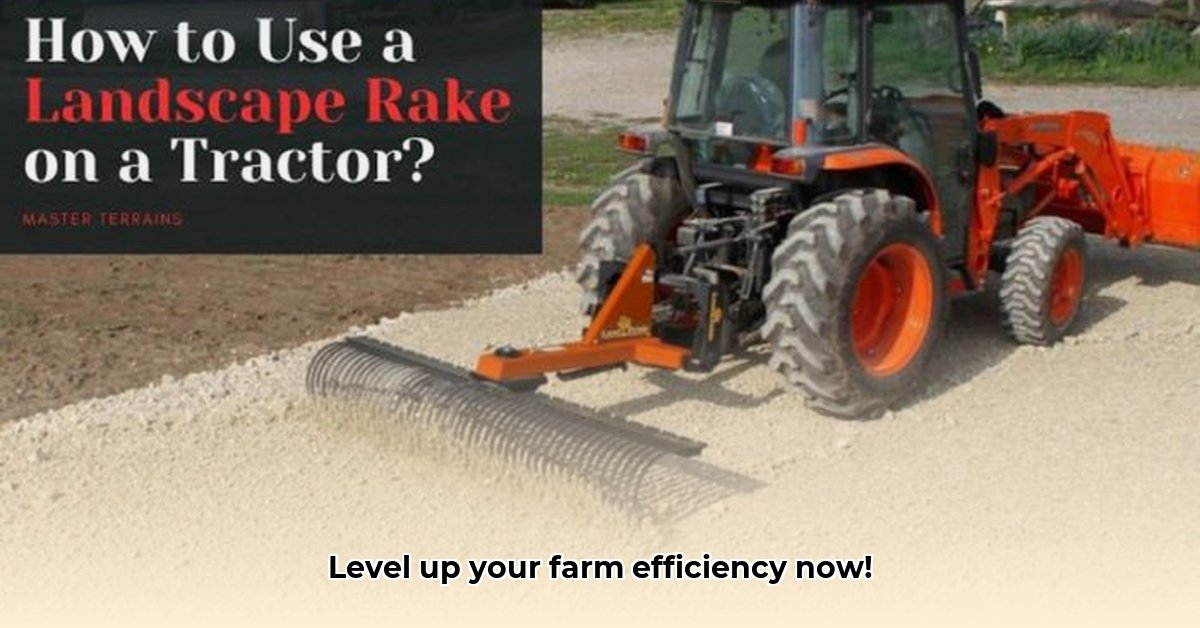
Tractor Landscape Rake Uses: Boosting Farm Efficiency and Sustainability
A tractor landscape rake is far more than a landscaping tool; it's a versatile asset for sustainable farming practices, boosting efficiency across numerous applications. This guide provides practical instructions and insights to maximize its use on your farm, from seedbed preparation to post-harvest cleanup. Are you ready to optimize your land management and improve your bottom line? For more information on landscape rakes, check out this helpful resource.
Getting Your Fields Ready: Seedbed Preparation for Optimal Planting
Achieving a perfectly smooth, level seedbed is crucial for successful planting. A tractor landscape rake efficiently levels uneven ground, creating ideal conditions for seed germination and strong growth. This eliminates the need for backbreaking manual labor, especially beneficial for large-scale operations. This consistent seedbed preparation translates to improved crop emergence rates and increased yields. Do you want a simpler, faster way to prepare your planting areas? A tractor landscape rake is the answer.
Cleaning Up the Mess: Efficient Debris Removal Before Planting
Before planting, removing debris—rocks, sticks, and crop residue—is essential for optimal results. A tractor landscape rake efficiently clears away obstructions, saving significant time and manual labor compared to traditional methods. This streamlined process frees up valuable time for other critical farm tasks, increasing overall productivity. How much time do you currently spend clearing your fields? A landscape rake can significantly reduce this time.
Spreading the Good Stuff: Even Distribution of Mulch and Topsoil
Uniform distribution of mulch and topsoil is key to soil health. The landscape rake evenly spreads these essential soil amendments, ensuring consistent coverage across your fields. This leads to better water retention, reduced weed pressure, and improved soil structure. This enhances soil fertility and promotes sustainable farming practices. Does nutrient uniformity limit your crop yields? A landscape rake can facilitate even application.
Beyond the Fields: Road and Driveway Maintenance
Maintaining well-maintained farm roads and driveways is crucial for efficient operations. A landscape rake effortlessly smooths out gravel roads and driveways, facilitating easier movement of equipment and personnel across your farm. This reduces equipment wear and tear and improves overall accessibility. Are rough roads slowing down your farm operations? This tool will improve efficiency.
Post-Harvest Cleanup: Streamlining the Next Planting Cycle
After harvest, efficient field cleanup is necessary for the next planting season. The landscape rake effectively removes leftover crop residue, preparing the land for subsequent planting. This reduces waste, minimizes disease and pest issues, and streamlines the planting cycle. How much time do you currently allocate to post-harvest field cleanup? Using a landscape rake can produce substantial time savings.
Tractor Landscape Rake Uses: A Comprehensive Overview of Advantages and Disadvantages
Let's objectively evaluate the benefits and drawbacks to determine if a landscape rake is suitable for your farm.
| Feature | Advantages | Disadvantages |
|---|---|---|
| Efficiency | Significantly reduces time and labor compared to manual methods. | May not be suitable for all soil types or terrains. |
| Cost-Effectiveness | Can replace multiple tools, offering long-term cost savings. | Requires a tractor with sufficient power; initial investment is necessary. |
| Sustainability | Promotes soil health, reduces erosion, and minimizes fuel consumption compared to multiple smaller tools. | Improper use can lead to soil compaction. |
| Versatility | Adaptable for various tasks, from seedbed preparation to post-harvest cleanup. | Effectiveness depends on debris size and soil conditions. |
Safety First: Operating Your Landscape Rake Safely and Effectively
Safe operation is paramount. Follow these steps for efficient and safe use:
Pre-Operation Inspection: Thoroughly inspect the rake and tractor before operation. Verify that all bolts are secure, tines are undamaged, and hydraulic fluid levels are correct.
Adjusting the Rake: Adjust the rake's angle and depth according to the specific task. Refer to your owner's manual for detailed instructions.
Safe Operating Procedures: Maintain a safe speed, appropriate for the terrain and task. Exercise caution near obstacles and ditches.
Personal Protective Equipment (PPE): Always wear safety glasses, hearing protection, and sturdy work boots.
Regular Maintenance: Regularly inspect and maintain your landscape rake according to the manufacturer's recommendations.
How to Choose the Right Tractor Horsepower for Optimal Performance
Matching tractor power to the landscape rake is critical for efficiency and sustainability. Several factors should be considered:
Understanding Your Needs: Farm Size and Rake Type
Assess your farm's acreage and the types of tasks the rake will perform. Heavier rakes demand more powerful tractors. A small farm will have different needs than a large-scale operation.
Calculating the Right Horsepower: A Practical Approach
Consider the following horsepower recommendations based on typical rake sizes:
| Rake Size (width) | Recommended Tractor HP Range | Notes |
|---|---|---|
| <6ft | 25-40 HP | Suitable for small farms, light-duty tasks |
| 6-8ft | 40-60 HP | Ideal for medium-sized farms, moderate use |
| >8ft | 60+ HP | Best for large-scale operations, heavy use |
Always consult the manufacturer's recommendations for your specific rake.
Sustainable Considerations: Fuel Efficiency and Soil Health
Prioritize fuel-efficient tractors to minimize environmental impact. Consider alternative fuels when available, such as biodiesel. Minimize soil compaction using wider tires or tracks.
The Long-Term View: Cost Analysis and Operational Efficiency
Consider factors beyond the initial purchase price, including fuel costs, maintenance, and resale value. A well-maintained, appropriately sized tractor and rake combination provides long-term operational efficiency and cost-effectiveness.
By following these guidelines and prioritizing safety, you can maximize the benefits of a tractor landscape rake, improving farm efficiency and promoting sustainable agricultural practices.